check engine YAMAHA VX-C 2022 Owners Manual
[x] Cancel search | Manufacturer: YAMAHA, Model Year: 2022, Model line: VX-C, Model: YAMAHA VX-C 2022Pages: 122, PDF Size: 5.65 MB
Page 5 of 122
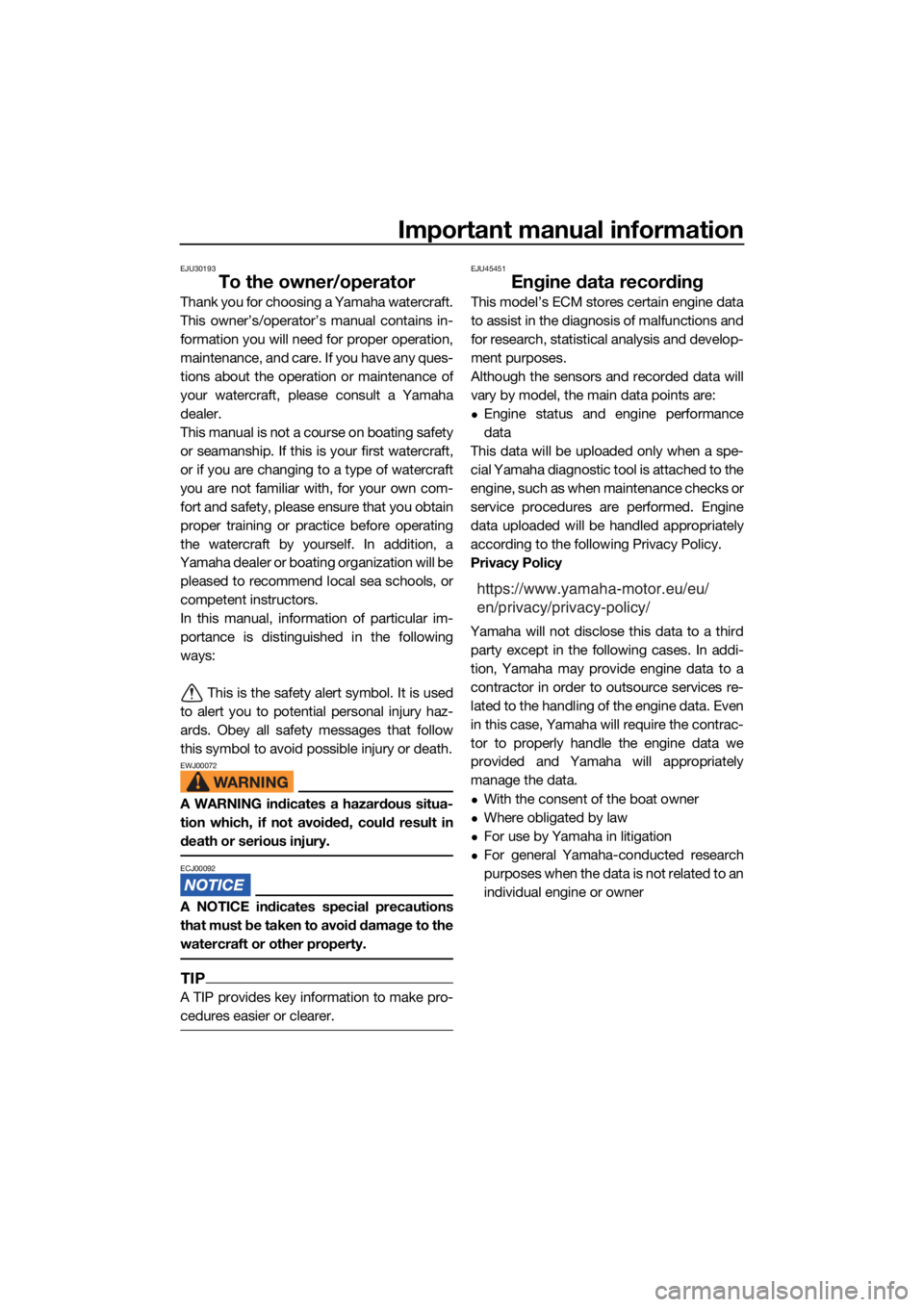
Important manual information
EJU30193
To the owner/operator
Thank you for choosing a Yamaha watercraft.
This owner’s/operator’s manual contains in-
formation you will need for proper operation,
maintenance, and care. If you have any ques-
tions about the operation or maintenance of
your watercraft, please consult a Yamaha
dealer.
This manual is not a course on boating safety
or seamanship. If this is your first watercraft,
or if you are changing to a type of watercraft
you are not familiar with, for your own com-
fort and safety, please ensure that you obtain
proper training or practice before operating
the watercraft by yourself. In addition, a
Yamaha dealer or boating organization will be pleased to recommend local sea schools, or
competent instructors.
In this manual, information of particular im-
portance is distinguished in the following
ways:
This is the safety alert symbol. It is used
to alert you to potential personal injury haz-
ards. Obey all safety messages that follow
this symbol to avoid possible injury or death.
EWJ00072
A WARNING indicates a hazardous situa-
tion which, if not avoided, could result in
death or serious injury.
ECJ00092
A NOTICE indicates special precautions
that must be taken to avoid damage to the
watercraft or other property.
TIP
A TIP provides key information to make pro-
cedures easier or clearer.
EJU45451
Engine data recording
This model’s ECM stores certain engine data
to assist in the diagnosis of malfunctions and
for research, statistical analysis and develop-
ment purposes.
Although the sensors and recorded data will
vary by model, the main data points are:
Engine status and engine performance
data
This data will be uploaded only when a spe-
cial Yamaha diagnostic tool is attached to the
engine, such as when maintenance checks or
service procedures are performed. Engine
data uploaded will be handled appropriately
according to the following Privacy Policy.
Privacy Policy
Yamaha will not disclose this data to a third party except in the following cases. In addi-
tion, Yamaha may provide engine data to a
contractor in order to outsource services re-
lated to the handling of the engine data. Even
in this case, Yamaha will require the contrac-
tor to properly handle the engine data we
provided and Yamaha will appropriately
manage the data.
With the consent of the boat owner
Where obligated by law
For use by Yamaha in litigation
For general Yamaha-conducted research
purposes when the data is not related to an
individual engine or owner
https://www.yamaha-motor.eu/eu/
en/privacy/privacy-policy/
UF4N71E0.book Page 3 Thursday, August 5, 2021 11:58 AM
Page 8 of 122

Table of contents
Accessory outlet ........................... 53
USB charger.................................. 53
Equipment operation ...................... 54 Equipment ..................................... 54
Seats ................................................ 54
Handgrip .......................................... 55
Reboarding grip ............................... 55
Reboarding step (VX / VX DELUXE /
VX CRUISER / VX LIMITED).......... 55
Bow eye ........................................... 56
Stern eyes ........................................ 56
Cleat ................................................. 56
Pull-up cleats (VX CRUISER / VX LIMITED) ....................................... 57
Storage compartments .................... 57
Fire extinguisher holder and cover ... 60
Operation and handling
requirements ................................... 61 Fuel requirements ......................... 61
Fuel................................................... 61
Engine oil requirements ................ 63
Engine oil .......................................... 63
Draining the bilge water ................ 65
Draining the bilge water on land ...... 65
Draining the bilge water on water .... 65
Transporting on a trailer ................ 66
First-time operation ........................ 67 Engine break-in ............................. 67
Pre-operation checks ..................... 68
Pre-operation checklist .................... 68
Pre-operation check points........... 70
Pre-launch checks ........................... 70
Post-launch checks ......................... 75
Operation ......................................... 77 Operating your watercraft ............. 77
Getting to know your watercraft ...... 77
Learning to operate your
watercraft ...................................... 77 Riding position ................................. 78
Launching the watercraft ................. 78
Starting the engine on water ............ 78
Stopping the engine ......................... 79
Leaving the watercraft ...................... 80
Operating the watercraft .................. 80
Turning the watercraft ...................... 81
Stopping the watercraft.................... 82
Operating the watercraft in reverse
or neutral (VX / VX DELUXE /
VX CRUISER / VX LIMITED) .......... 83
Boarding the watercraft.................... 84
Starting off........................................ 87
Capsized watercraft ......................... 88
Beaching and docking the watercraft ...................................... 88
Operating in weeded areas .............. 89
After removing the watercraft from
the water ....................................... 90
Care and storage ............................ 91Post-operation care ...................... 91
Flushing the cooling water
passages....................................... 91
Cleaning the watercraft .................... 92
Battery care ...................................... 92
Long-term storage ........................ 94
Cleaning ........................................... 94
Lubrication ....................................... 94
Rustproofing ..................................... 95
Maintenance .................................... 97 Maintenance ................................. 97
Periodic maintenance chart ............. 98
Engine oil and oil filter .................... 100
Specifications ................................ 101Specifications ............................. 101
Trouble recovery ........................... 103 Troubleshooting .......................... 103
Troubleshooting chart .................... 103
UF4N71E0.book Page 2 Thursday, August 5, 2021 11:58 AM
Page 20 of 122
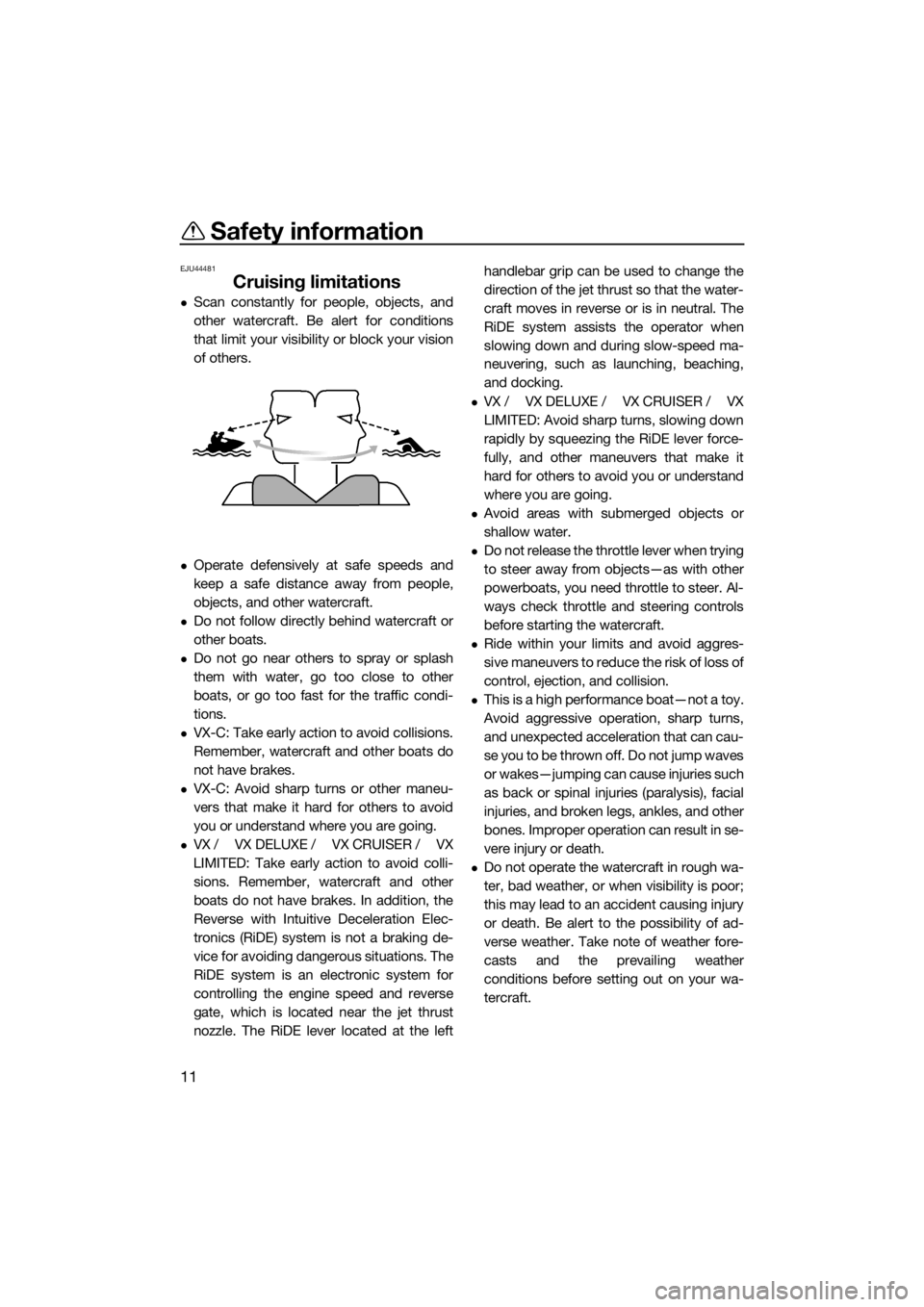
Safety information
11
EJU44481
Cruising limitations
Scan constantly for people, objects, and
other watercraft. Be alert for conditions
that limit your visibility or block your vision
of others.
Operate defensively at safe speeds and
keep a safe distance away from people,
objects, and other watercraft.
Do not follow directly behind watercraft or
other boats.
Do not go near others to spray or splash
them with water, go too close to other
boats, or go too fast for the traffic condi-
tions.
VX-C: Take early action to avoid collisions.
Remember, watercraft and other boats do
not have brakes.
VX-C: Avoid sharp turns or other maneu-
vers that make it hard for others to avoid
you or understand where you are going.
VX / VX DELUXE / VX CRUISER / VX
LIMITED: Take early action to avoid colli- sions. Remember, watercraft and other
boats do not have brakes. In addition, the
Reverse with Intuitive Deceleration Elec-
tronics (RiDE) system is not a braking de-
vice for avoiding dangerous situations. The
RiDE system is an electronic system for
controlling the engine speed and reverse
gate, which is located near the jet thrust
nozzle. The RiDE lever located at the left handlebar grip can be used to change the
direction of the jet thrust so that the water-
craft moves in reverse or is in neutral. The
RiDE system assists the operator when
slowing down and during slow-speed ma-
neuvering, such as launching, beaching,
and docking.
VX / VX DELUXE / VX CRUISER / VX
LIMITED: Avoid sharp turns, slowing down rapidly by squeezing the RiDE lever force-
fully, and other maneuvers that make it
hard for others to avoid you or understand
where you are going.
Avoid areas with submerged objects or
shallow water.
Do not release the throttle lever when trying
to steer away from objects—as with other
powerboats, you need throttle to steer. Al-
ways check throttle and steering controls
before starting the watercraft.
Ride within your limits and avoid aggres-
sive maneuvers to reduce the risk of loss of
control, ejection, and collision.
This is a high performance boat—not a toy.
Avoid aggressive operation, sharp turns,
and unexpected acceleration that can cau-
se you to be thrown off. Do not jump waves
or wakes—jumping can cause injuries such
as back or spinal injuries (paralysis), facial
injuries, and broken legs, ankles, and other
bones. Improper operation can result in se-
vere injury or death.
Do not operate the watercraft in rough wa-
ter, bad weather, or when visibility is poor;
this may lead to an accident causing injury
or death. Be alert to the possibility of ad-
verse weather. Take note of weather fore-
casts and the prevailing weather
conditions before setting out on your wa-
tercraft.
UF4N71E0.book Page 11 Thursday, August 5, 2021 11:58 AM
Page 22 of 122
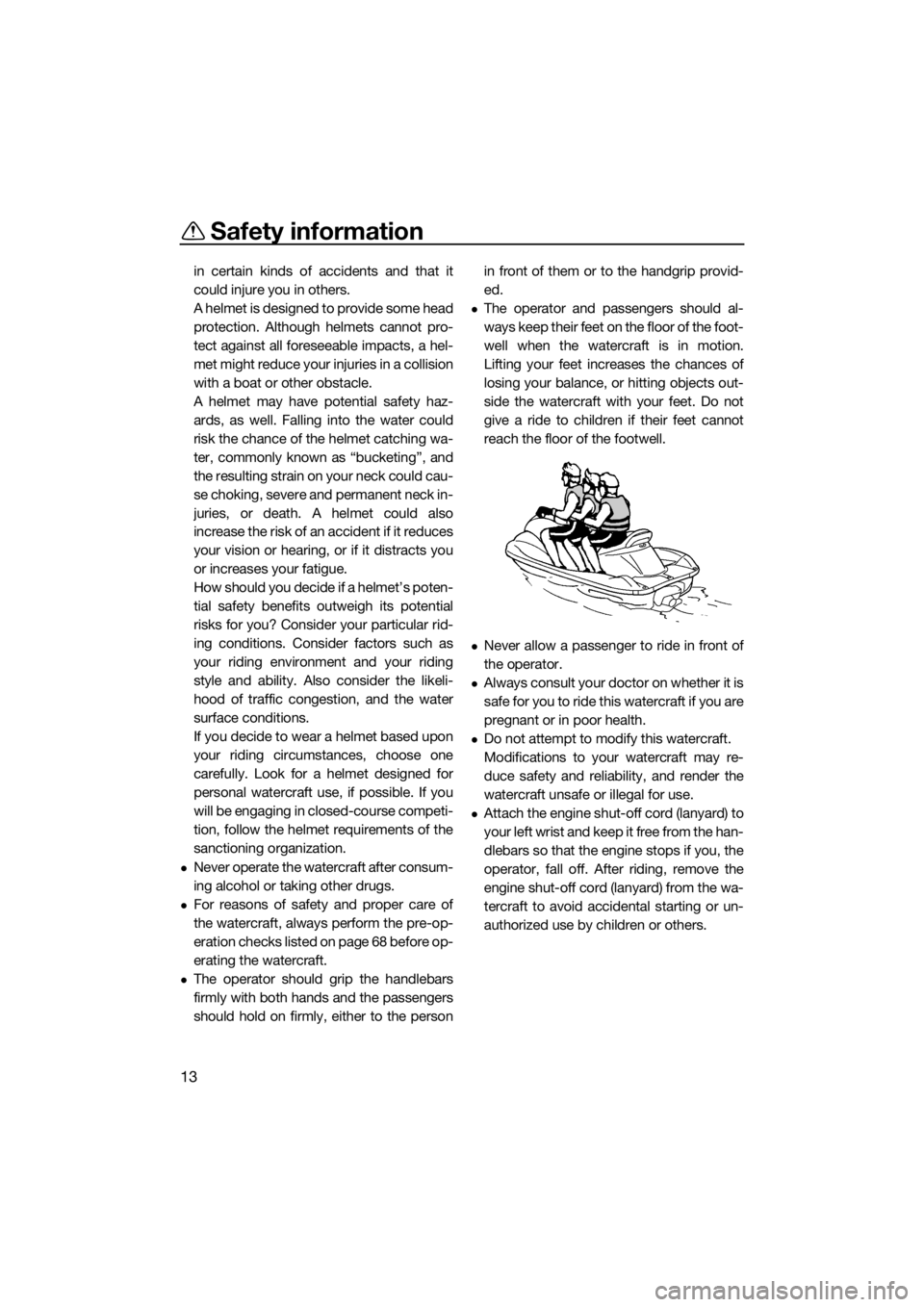
Safety information
13
in certain kinds of accidents and that it
could injure you in others.
A helmet is designed to provide some head
protection. Although helmets cannot pro-
tect against all foreseeable impacts, a hel-
met might reduce your injuries in a collision
with a boat or other obstacle.
A helmet may have potential safety haz-
ards, as well. Falling into the water could
risk the chance of the helmet catching wa-
ter, commonly known as “bucketing”, and
the resulting strain on your neck could cau-
se choking, severe and permanent neck in-
juries, or death. A helmet could also
increase the risk of an accident if it reduces
your vision or hearing, or if it distracts you
or increases your fatigue.
How should you decide if a helmet’s poten-
tial safety benefits outweigh its potential
risks for you? Consider your particular rid-
ing conditions. Consider factors such as
your riding environment and your riding
style and ability. Also consider the likeli-
hood of traffic congestion, and the water
surface conditions.
If you decide to wear a helmet based upon
your riding circumstances, choose one
carefully. Look for a helmet designed for
personal watercraft use, if possible. If you
will be engaging in closed-course competi-
tion, follow the helmet requirements of the
sanctioning organization.
Never operate the watercraft after consum-
ing alcohol or taking other drugs.
For reasons of safety and proper care of
the watercraft, always perform the pre-op-
eration checks listed on page 68 before op-
erating the watercraft.
The operator should grip the handlebars
firmly with both hands and the passengers
should hold on firmly, either to the person in front of them or to the handgrip provid-
ed.
The operator and passengers should al-
ways keep their feet on the floor of the foot-
well when the watercraft is in motion.
Lifting your feet increases the chances of
losing your balance,
or hitting objects out-
side the watercraft with your feet. Do not
give a ride to children if their feet cannot
reach the floor of the footwell.
Never allow a passenger to ride in front of
the operator.
Always consult your doctor on whether it is
safe for you to ride this watercraft if you are
pregnant or in poor health.
Do not attempt to modify this watercraft.
Modifications to your watercraft may re-
duce safety and reliability, and render the
watercraft unsafe or illegal for use.
Attach the engine shut-off cord (lanyard) to
y o u r l ef t w r is t an d k ee p i t fr e e f r o m t h e h an -
dlebars so that the engine stops if you, the
operator, fall off. After riding, remove the
engine shut-off cord (lanyard) from the wa-
tercraft to avoid accidental starting or un-
authorized use by children or others.
UF4N71E0.book Page 13 Thursday, August 5, 2021 11:58 AM
Page 25 of 122
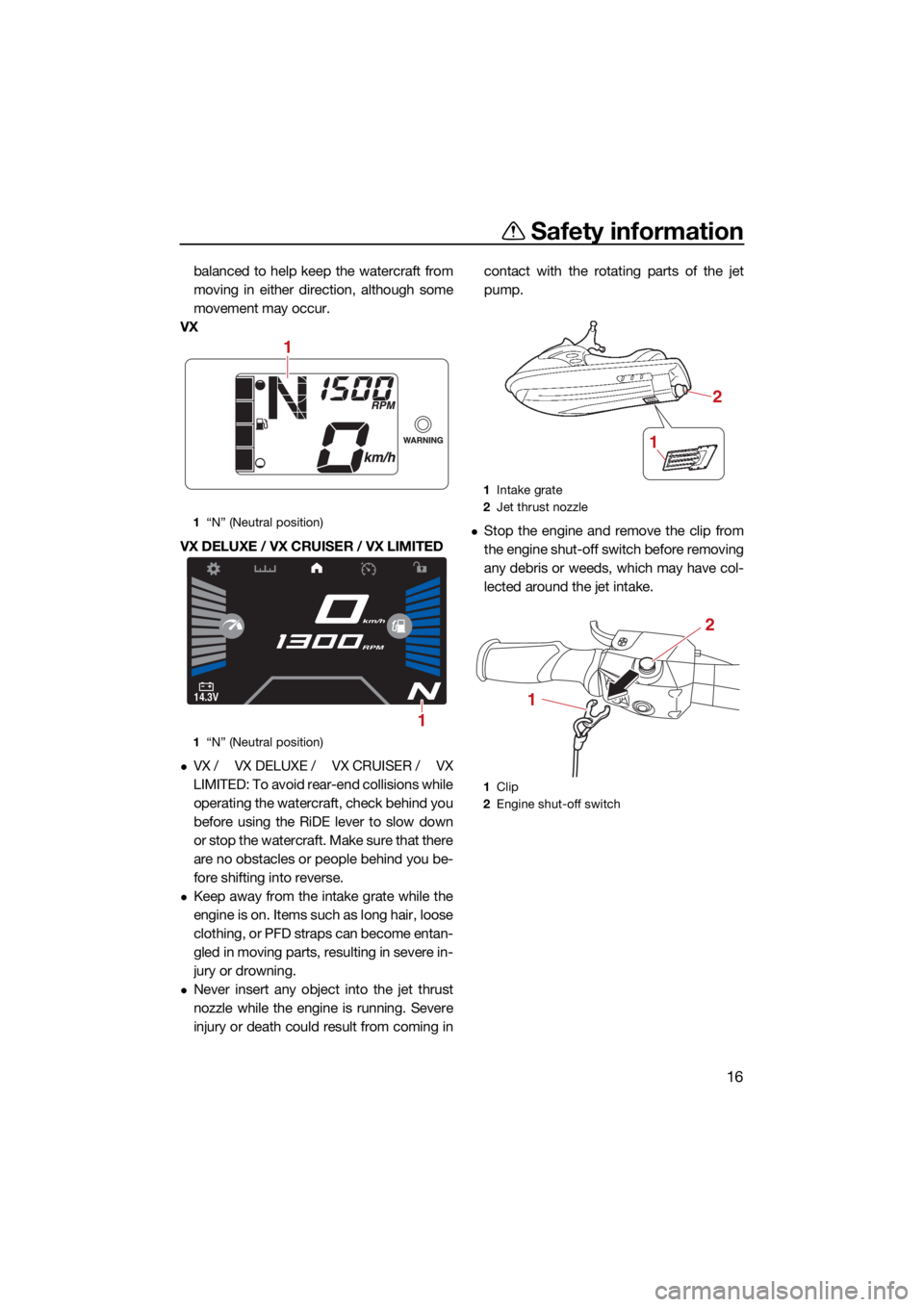
Safety information
16
balanced to help keep the watercraft from
moving in either direction, although some
movement may occur.
VX
VX DELUXE / VX CRUISER / VX LIMITED
VX / VX DELUXE / VX CRUISER / VX
LIMITED: To avoid rear-end collisions while operating the watercraft, check behind you
before using the RiDE lever to slow down
or stop the watercraft. Make sure that there
are no obstacles or people behind you be-
fore shifting into reverse.
Keep away from the intake grate while the
engine is on. Items such as long hair, loose
clothing, or PFD straps can become entan-
gled in moving parts, resulting in severe in-
jury or drowning.
Never insert any object into the jet thrust
nozzle while the engine is running. Severe
injury or death could result from coming in contact with the rotating parts of the jet
pump.
Stop the engine and remove the clip from
the engine shut-off switch before removing
any debris or weeds, which may have col-
lected around the jet intake.1
“N” (Neutral position)
1 “N” (Neutral position)
1
14.3V
km/h
RPM
1
1 Intake grate
2 Jet thrust nozzle
1 Clip
2 Engine shut-off switch
1
2
1
2
UF4N71E0.book Page 16 Thursday, August 5, 2021 11:58 AM
Page 37 of 122
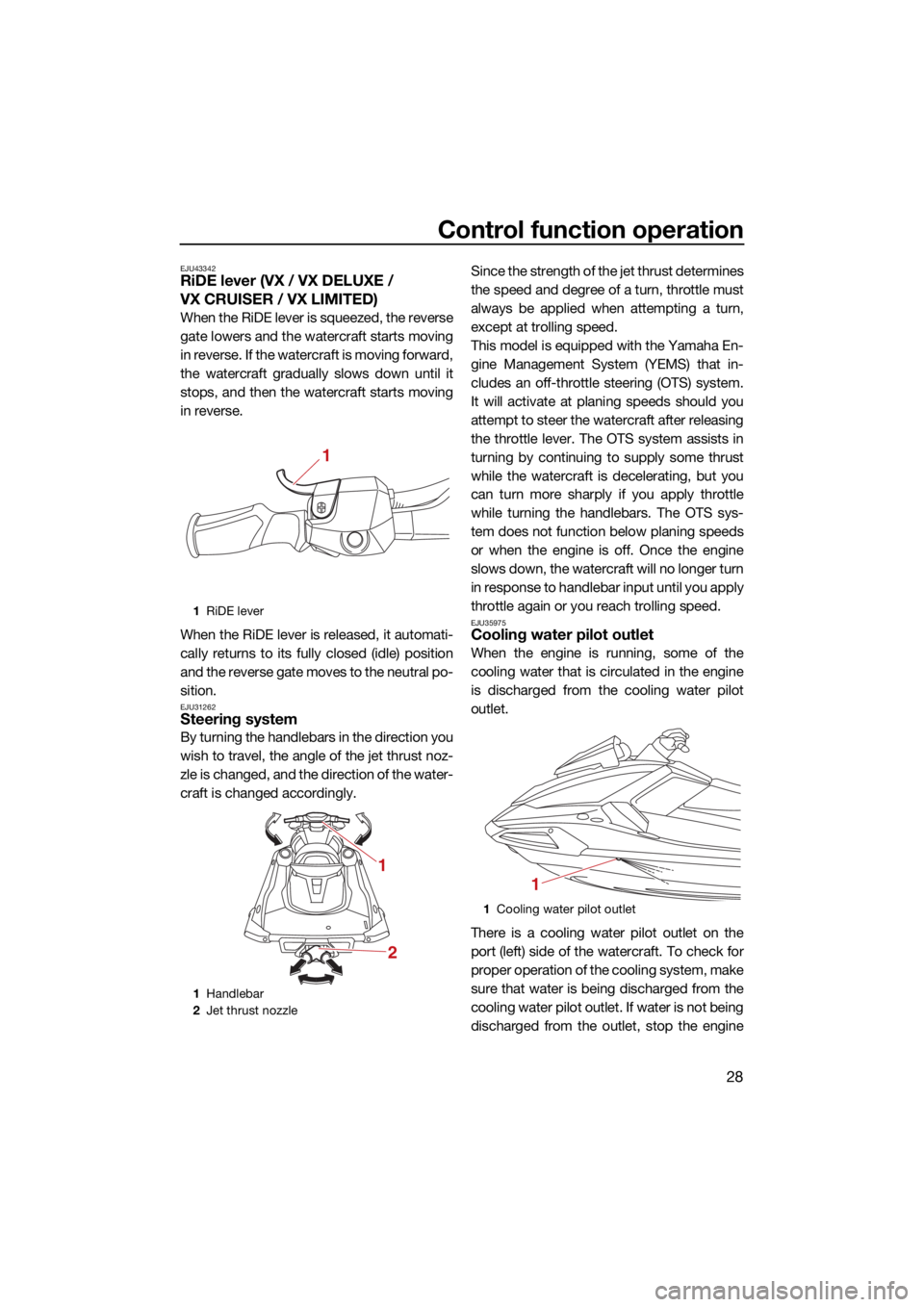
Control function operation
28
EJU43342RiDE lever (VX / VX DELUXE /
VX CRUISER / VX LIMITED)
When the RiDE lever is squeezed, the reverse
gate lowers and the watercraft starts moving
in reverse. If the watercraft is moving forward,
the watercraft gradually slows down until it
stops, and then the watercraft starts moving
in reverse.
When the RiDE lever is released, it automati-
cally returns to its fully closed (idle) position
and the reverse gate moves to the neutral po-
sition.
EJU31262Steering system
By turning the handlebars in the direction you
wish to travel, the angle of the jet thrust noz-
zle is changed, and the direction of the water-
craft is changed accordingly.Since the strength of the jet thrust determines
the speed and degree of a turn, throttle must
always be applied when attempting a turn,
except at trolling speed.
This model is equipped with the Yamaha En-
gine Management System (YEMS) that in-
cludes an off-throttle steering (OTS) system.
It will activate at planing speeds should you
attempt to steer the watercraft after releasing
the throttle lever. The OTS system assists in
turning by continuing to supply some thrust
while the watercraft is decelerating, but you
can turn more sharply if you apply throttle
while turning the handlebars. The OTS sys-
tem does not function below planing speeds
or when the engine is off. Once the engine
slows down, the watercraft will no longer turn
in response to handlebar input until you apply
throttle again or you reach trolling speed.
EJU35975Cooling water pilot outlet
When the engine is running, some of the
cooling water that is circulated in the engine
is discharged from the cooling water pilot
outlet.
There is a cooling water pilot outlet on the
port (left) side of the watercraft. To check for
proper operation of the cooling system, make
sure that water is being discharged from the
cooling water pilot outlet. If water is not being
discharged from the outlet, stop the engine
1
RiDE lever
1 Handlebar
2 Jet thrust nozzle
1
1
2
1 Cooling water pilot outlet
1
UF4N71E0.book Page 28 Thursday, August 5, 2021 11:58 AM
Page 38 of 122
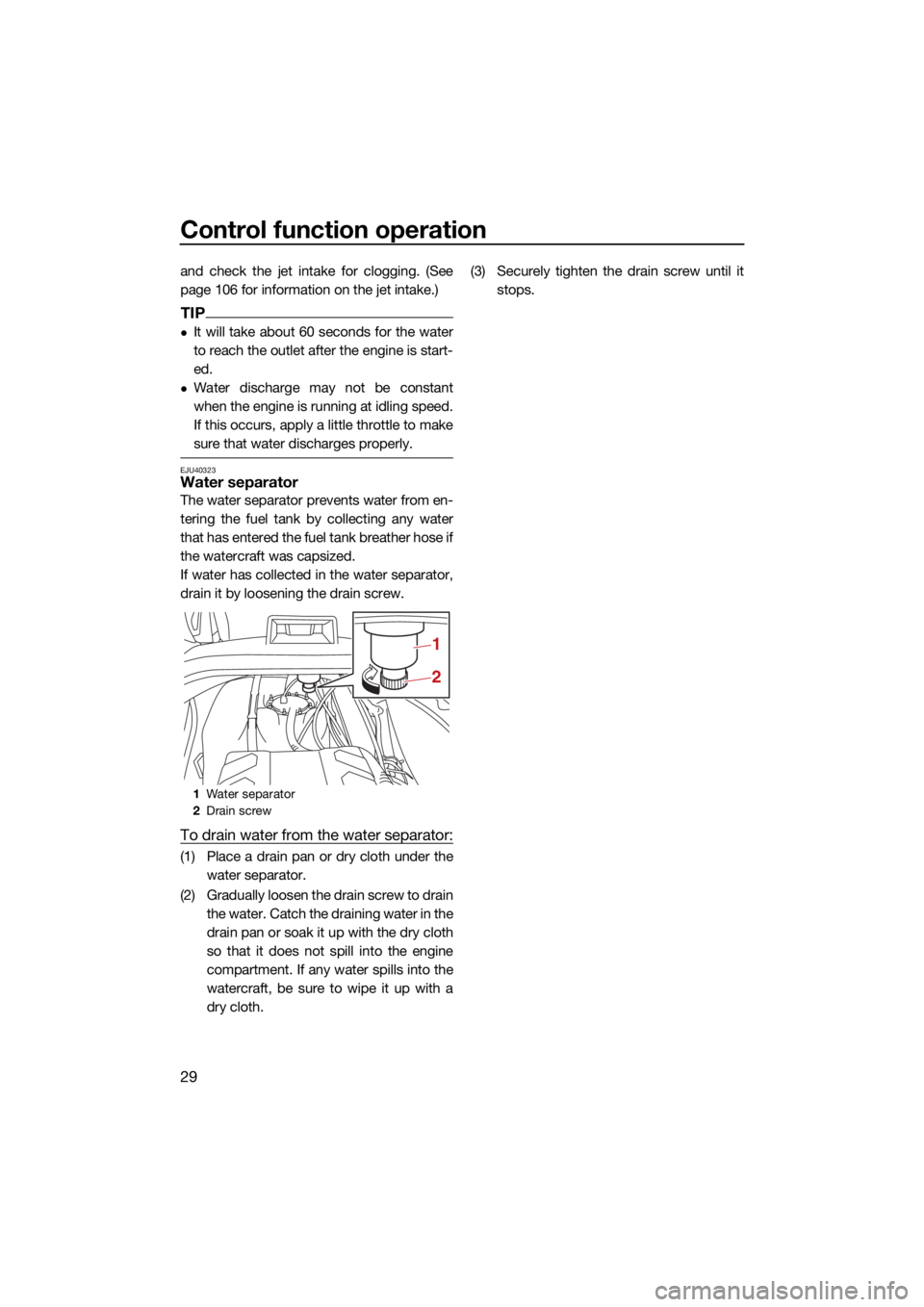
Control function operation
29
and check the jet intake for clogging. (See
page 106 for information on the jet intake.)
TIP
It will take about 60 seconds for the water
to reach the outlet after the engine is start-
ed.
Water discharge may not be constant
when the engine is running at idling speed.
If this occurs, apply a little throttle to make
sure that water discharges properly.
EJU40323Water separator
The water separator prevents water from en-
tering the fuel tank by collecting any water
that has entered the fuel tank breather hose if
the watercraft was capsized.
If water has collected in the water separator,
drain it by loosening the drain screw.
To drain water from the water separator:
(1) Place a drain pan or dry cloth under thewater separator.
(2) Gradually loosen the drain screw to drain the water. Catch the draining water in the
drain pan or soak it up with the dry cloth
so that it does not spill into the engine
compartment. If any water spills into the
watercraft, be sure to wipe it up with a
dry cloth. (3) Securely tighten the drain screw until it
stops.
1Water separator
2 Drain screw
1
2
UF4N71E0.book Page 29 Thursday, August 5, 2021 11:58 AM
Page 46 of 122
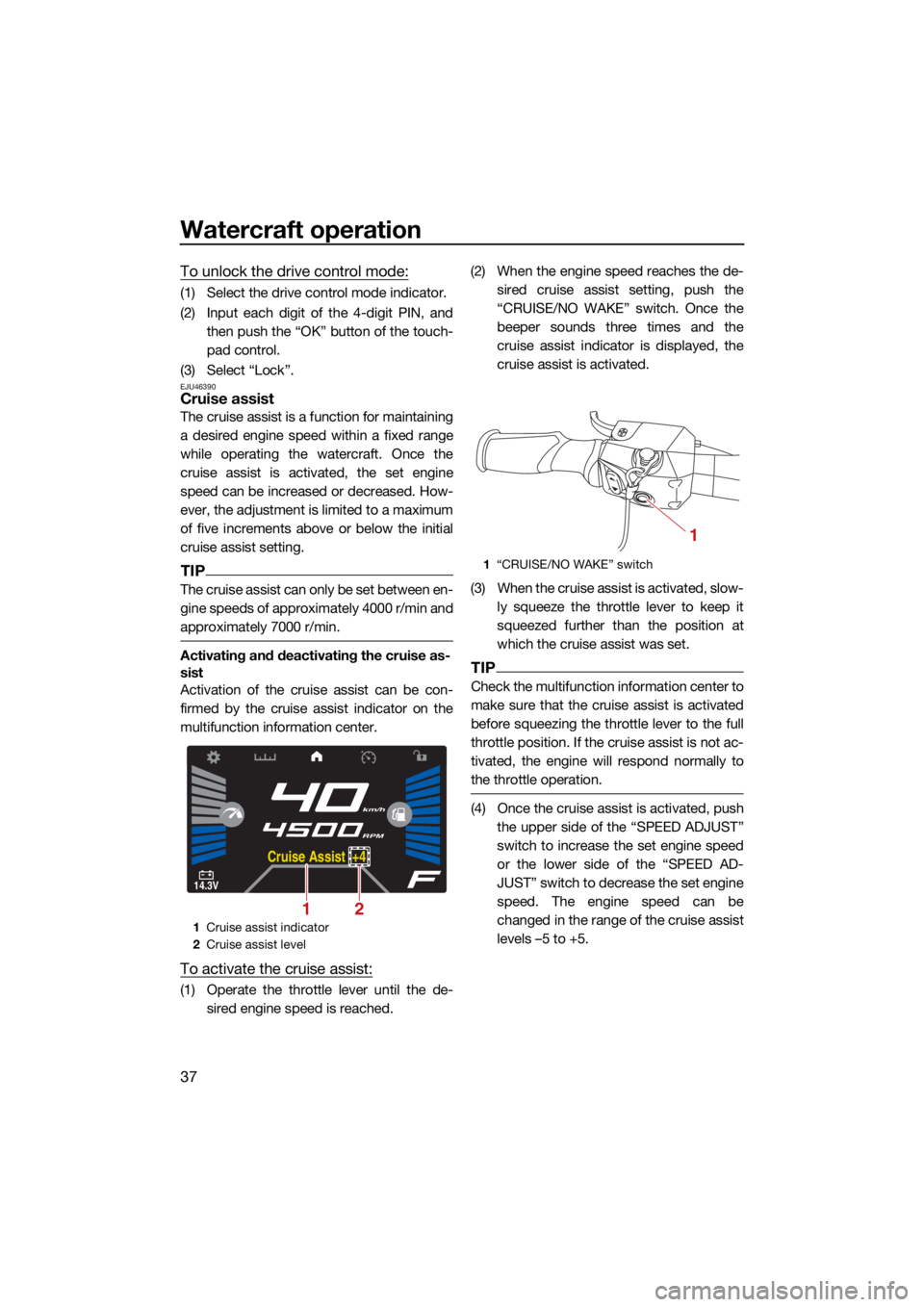
Watercraft operation
37
To unlock the drive control mode:
(1) Select the drive control mode indicator.
(2) Input each digit of the 4-digit PIN, andthen push the “OK” button of the touch-
pad control.
(3) Select “Lock”.
EJU46390Cruise assist
The cruise assist is a function for maintaining
a desired engine speed within a fixed range
while operating the watercraft. Once the
cruise assist is activated, the set engine
speed can be increased or decreased. How-
ever, the adjustment is limited to a maximum
of five increments above or below the initial
cruise assist setting.
TIP
The cruise assist can only be set between en-
gine speeds of approximately 4000 r/min and
approximately 7000 r/min.
Activating and deactivating the cruise as-
sist
Activation of the cruise assist can be con-
firmed by the cruise assist indicator on the
multifunction information center.
To activate the cruise assist:
(1) Operate the throttle lever until the de- sired engine speed is reached. (2) When the engine speed reaches the de-
sired cruise assist setting, push the
“CRUISE/NO WAKE” switch. Once the
beeper sounds three times and the
cruise assist indicator is displayed, the
cruise assist is activated.
(3) When the cruise assist is activated, slow- ly squeeze the throttle lever to keep it
squeezed further than the position at
which the cruise assist was set.
TIP
Check the multifunction information center to
make sure that the cruise assist is activated
before squeezing the throttle lever to the full
throttle position. If the cruise assist is not ac-
tivated, the engine will respond normally to
the throttle operation.
(4) Once the cruise assist is activated, pushthe upper side of the “SPEED ADJUST”
switch to increase the set engine speed
or the lower side of the “SPEED AD-
JUST” switch to decrease the set engine
speed. The engine speed can be
changed in the range of the cruise assist
levels –5 to +5.
1Cruise assist indicator
2 Cruise assist level
14.3V
RPM
Cruise Assist +4
km/h
21
1“CRUISE/NO WAKE” switch
1
UF4N71E0.book Page 37 Thursday, August 5, 2021 11:58 AM
Page 48 of 122
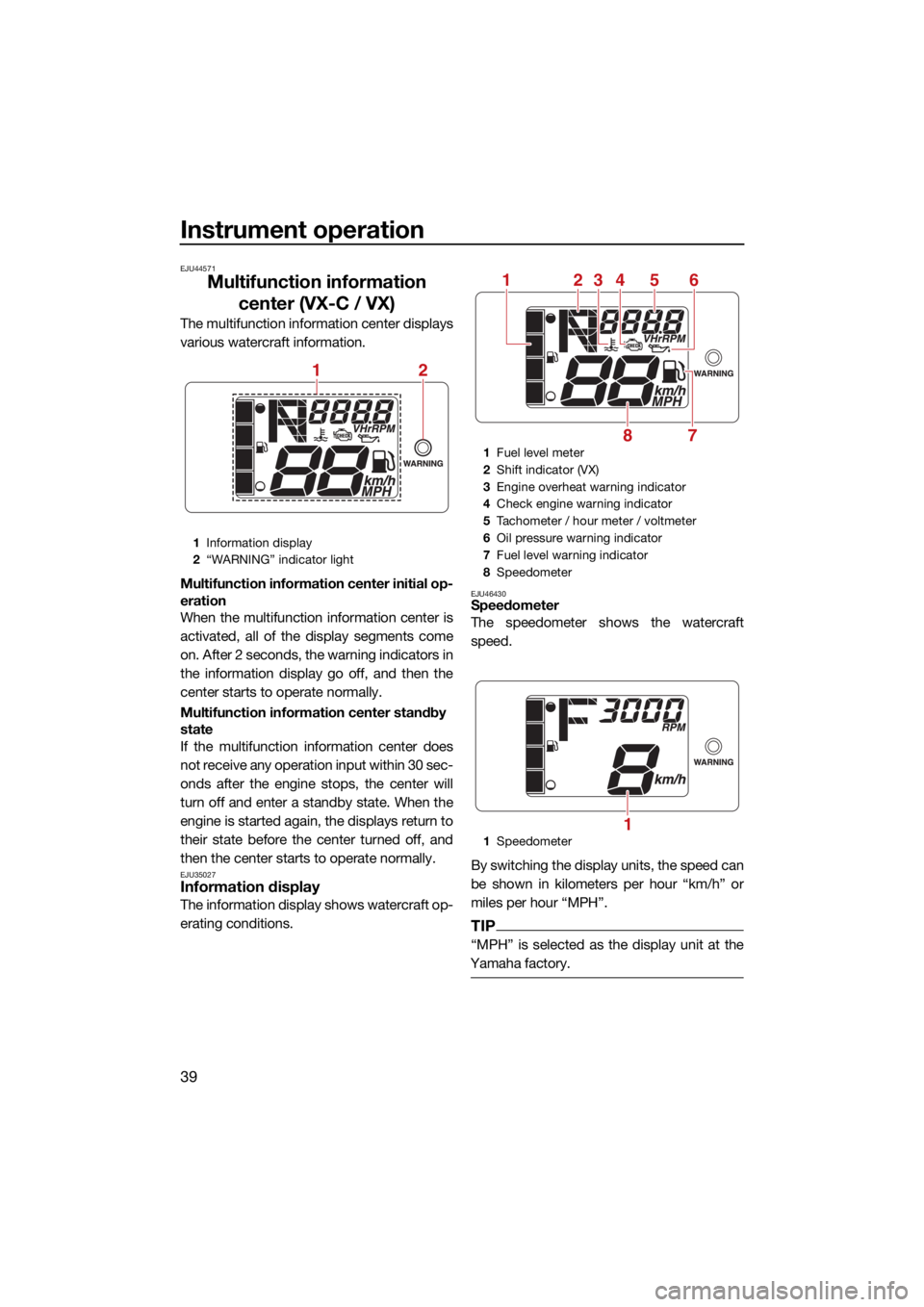
Instrument operation
39
EJU44571
Multifunction information center (VX-C / VX)
The multifunction information center displays
various watercraft information.
Multifunction information center initial op-
eration
When the multifunction information center is
activated, all of the display segments come
on. After 2 seconds, the warning indicators in
the information display go off, and then the
center starts to operate normally.
Multifunction information center standby
state
If the multifunction information center does
not receive any operation input within 30 sec-
onds after the engine stops, the center will
turn off and enter a standby state. When the
engine is started again, the displays return to
their state before the center turned off, and
then the center starts to operate normally.
EJU35027Information display
The information display shows watercraft op-
erating conditions.
EJU46430Speedometer
The speedometer shows the watercraft
speed.
By switching the display units, the speed can
be shown in kilometers per hour “km/h” or
miles per hour “MPH”.
TIP
“MPH” is selected as the display unit at the
Yamaha factory.
1 Information display
2 “WARNING” indicator light
12
1Fuel level meter
2 Shift indicator (VX)
3 Engine overheat warning indicator
4 Check engine warning indicator
5 Tachometer / hour meter / voltmeter
6 Oil pressure warning indicator
7 Fuel level warning indicator
8 Speedometer
1 Speedometer
251346
78
1
UF4N71E0.book Page 39 Thursday, August 5, 2021 11:58 AM
Page 50 of 122
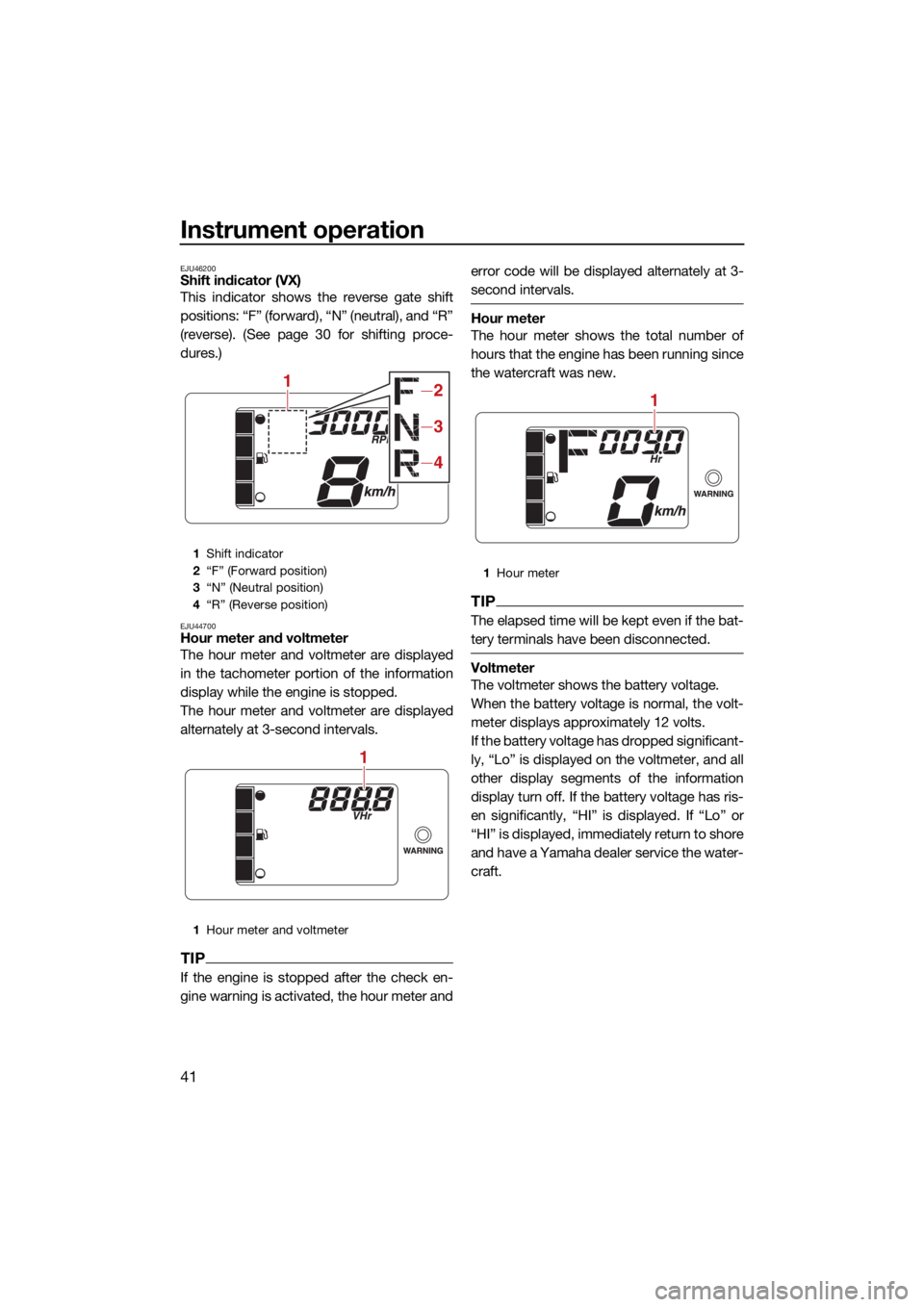
Instrument operation
41
EJU46200Shift indicator (VX)
This indicator shows the reverse gate shift
positions: “F” (forward), “N” (neutral), and “R”
(reverse). (See page 30 for shifting proce-
dures.)
EJU44700Hour meter and voltmeter
The hour meter and voltmeter are displayed
in the tachometer portion of the information
display while the engine is stopped.
The hour meter and voltmeter are displayed
alternately at 3-second intervals.
TIP
If the engine is stopped after the check en-
gine warning is activated, the hour meter anderror code will be displayed alternately at 3-
second intervals.
Hour meter
The hour meter shows the total number of
hours that the engine has been running since
the watercraft was new.
TIP
The elapsed time will be kept even if the bat-
tery terminals have been disconnected.
Voltmeter
The voltmeter shows the battery voltage.
When the battery voltage is normal, the volt-
meter displays approximately 12 volts.
If the battery voltage has dropped significant-
ly, “Lo” is displayed on the voltmeter, and all
other display segments of the information
display turn off. If the battery voltage has ris-
en significantly, “HI” is displayed. If “Lo” or
“HI” is displayed, immediately return to shore
and have a Yamaha dealer service the water-
craft.
1
Shift indicator
2 “F” (Forward position)
3 “N” (Neutral position)
4 “R” (Reverse position)
1 Hour meter and voltmeter
12
3
4
1
1Hour meter
1
UF4N71E0.book Page 41 Thursday, August 5, 2021 11:58 AM